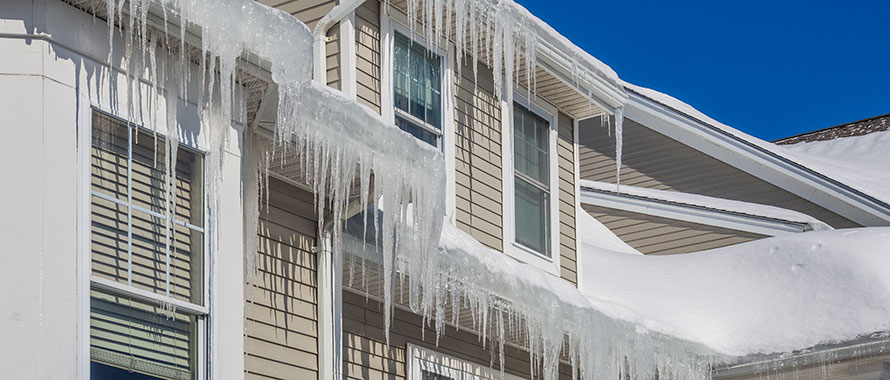Heavy snow, built-up ice and fluctuating temperatures have caused headaches and hardships for homeowners and business owners across the U.S. and Canada this winter. In Texas earlier this month, winter storms led to the collapse of a Waco woman’s living room ceiling at the house she was renting and downed multiple trees in Austin, including one that broke through a fence and nearly struck a home. Ice-related roof damage was being reported after recent storms in west Michigan and upstate New York, while experts in Kansas City warned property owners that melting snow from recent storms could even cause home foundation problems.
“The winter storm damage that can occur is often not as noticeable at first,” said Kate Wright, Associate Vice President, Regional Practice Group Leader, Personal Insurance, Burns & Wilcox, Indianapolis, Indiana. “Ice dam damage can be very subtle when it begins. A slow leak isn’t always visible as the ice and snow melts until it is coming through your ceiling or walls, and then you have a big problem.”
While Homeowners Insurance and Commercial Property Insurance can cover ice damage and other winter storm effects, some individuals face even greater problems after a storm loss because they are not properly insured. In Memphis, Tennessee, a February ice storm left many lower-income, uninsured residents not able to repair damage from fallen tree limbs or pay for temporary housing, the Daily Memphian reported.
“Winter storm damage can be really severe, depending on how bad the storm is, of course,” said Avi Kanwar, Underwriter, Commercial Insurance, Burns & Wilcox, Indianapolis, Indiana. “With climate change being what it is, we have definitely seen an increased frequency with regard to that. In the insurance industry, one of the things we are struggling with is that rates have gone up as a direct result of all of the disasters that rolled through last year. Capacity is also shrinking in the property market, so insurance can be harder to place.”
Winter storm damage can force residents out of their homes
According to the National Weather Service, ice dams often develop on roofs when built-up heavy snow melts during the day and refreezes when temperatures decrease at night, creating a cycle that allows melted water to find its way underneath shingles and enter the home. The damage to walls and contents can be significant, the NWS notes, and it may go unnoticed at first.
“Damage can be caused by the weight of the ice, snow or sleet on your roof, and if you did not clean your gutters out in the fall, the ice can expand your gutters and cause a slow leak in your roof,” Wright explained. “Even if the ice dam causes your roof to fall through or part of your roof to collapse, it is typically covered on your Homeowners Insurance, but I would advise clients to consult the specific coverages with their insurance advisor.”
Separate structures such as detached garages, fences, docks and piers may not be covered, she said.

This type of [ice dam] damage can be on a scale of very large and costly — replacing your roof and remediating mold because of water damage, for example — or it can potentially be minor, if you catch it in time.
In 2019, insurers in Minnesota were preparing for a record-breaking year for ice dam claims, which were anticipated to top a prior record of $50 million total. When damage is limited to damp insulation and stained walls and ceilings, a single claim may cost around a few thousand dollars, Minnesota Public Radio News reported at the time. For these smaller claims, Wright said, the cost “may be only slightly over your deductible, so it then becomes a conversation with your insurance broker to determine whether it is worth turning in a claim, so they don’t run into a claims frequency problem with their current carrier.”
“This type of damage can be on a scale of very large and costly — replacing your roof and remediating mold because of water damage, for example — or it can potentially be minor, if you catch it in time,” Wright said.
Beyond ice dams, Homeowners Insurance can also cover winter storm damage to a home resulting from downed trees, wind, hail and other perils. When a loss occurs, one of the most critical but often overlooked aspects of Homeowners Insurance is coverage for loss of use and extra expenses, such as food, that may be incurred while staying elsewhere. “If your home becomes uninhabitable because of water damage, your insurance coverage can reimburse you to stay in a hotel temporarily while your home is repaired and remediated, until you can move back in safely,” she said. “That reimbursement of living expenses is so important in this case.”
This is especially key for homeowners who work out of their homes, she said. In addition, the high demand for contractors and ongoing shortages of building supplies can make repairs take much longer than usual. “It could be that you are out of your home for a month or two to get damage repaired,” Wright said. “There is only so much you can do to prevent damage. Nobody can stop Mother Nature, and when Mother Nature takes a turn, having that coverage can be the difference between financially surviving the winter storm or not.”
Location, ‘spread of risk’ among considerations for commercial property owners
Over a year after a historic winter storm hit Texas, reportedly costing residents more than $10 billion in economic losses, some business owners are still struggling, Spectrum News 1 reported this month. One restaurant owner told the news outlet that she spent $20,000 to rebuild, lost about $60,000 in revenue, and was still trying to get the business back on its feet.

There is only so much you can do to prevent damage. Nobody can stop Mother Nature, and when Mother Nature takes a turn, having that coverage can be the difference between financially surviving the winter storm or not.
While the winter storms that hit Texas this month were much less severe, the increasing risk of destructive weather events has made finding Commercial Property Insurance in Texas more difficult, Kanwar said. In fact, Texans were gearing up for more freezing temperatures and ice expected to hit Feb. 23, Local Profile reported Feb. 22.
“Writing Commercial Property Insurance in Texas can be very difficult, especially if it is coastal,” he said. “Basic perils coverage is more available with a lot of these carriers, but if you are insuring your property for only basic perils, the weight of ice and snow is not something that would be covered. Basic may be your only option, but in the event of a bad ice storm, you might not have a covered loss.”
In some cases, property owners — particularly investors who are looking to flip a property quickly — may avoid buying full coverage on their Commercial Property Insurance because they are only looking to meet the requirements of their bank loan rather than insure the property to value. When a property owner has multiple buildings in the same general region, this can be even riskier.
“If they have a large schedule of investment properties in one area, and each one has a roof claim that starts at $10,000 or $25,000, and you factor in the increased cost of materials and labor as a result of supply chain disruptions, you are looking at quite a substantial loss, with a lengthy repair time,” Kanwar said. “If you are not also obtaining coverage for your business income and extra expenses on your Commercial Property Insurance, you could land yourself in a very difficult position. The spread of risk is certainly something to look at.”
Coverage for loss of business income and extra expense can be packaged into a Commercial Property Insurance policy. “These are triggered when the insured property is directly damaged by a covered event,” Kanwar explained. “An example of extra expense would be if you needed to move your property to another location to continue operations, or if you needed any expedited repairs in order to stop more damage from occurring.”

If you are not also obtaining coverage for your business income and extra expenses on your Commercial Property Insurance, you could land yourself in a very difficult position.
Properties that may be more prone to serious winter weather losses include buildings with large rooflines, large apartment complexes, and vacant buildings that are not being checked on often. Property owners should be “very aware” of what is and is not covered in their policy. “Extra expense coverage is not just something that would be included automatically in a property policy, and there is a lot of cleanup and activity after a big loss that you would want covered,” he said.
In January, heavy snow loads caused “catastrophic structural damage” to a historic building in Roslyn, Washington, the Daily Record reported. Last year, two winter storms in western Canada caused over $134 million in insured damages, according to the Insurance Bureau of Canada. These examples underscore just how precarious it can be for commercial property owners to carry only basic insurance coverage or to self-insure. “If you are self-insuring, you are retaining that risk in the event of a disaster and you should be very cognizant of that,” Kanwar said.
In addition to having a broad Commercial Property Insurance policy, taking the correct actions in response to winter storm damage is also important and can help limit potential liability for commercial property owners, who should also carry Commercial General Liability (CGL) Insurance. Landlords who do not mitigate additional damage after a roof leak, for example, could face health violations or lawsuits from tenants if mold develops.
“Property owners should be involved in the claims process, and not sitting on any part of the process and causing delays,” Kanwar said. “You are already dealing with a disaster; you do not need to add a lawsuit on top of it.”
Property owners should be proactive, review insurance with broker
Major snowstorms, or “bomb cyclones,” are likely to become more common and more destructive due to climate change, a climate scientist wrote in The Hill on Feb. 1. With that in mind, now may be a good time for property owners to review their insurance coverage. “Especially with everything going on right now, it is probably a good idea to revisit their policies with their broker right now to make sure they are covered,” Kanwar said.
Worsening severe weather events can also serve as a reminder to take risk mitigation seriously. For homeowners and commercial property owners, this can include roof maintenance and cleaning gutters regularly. “Clearing your gutters of leaves and debris is a big part of it,” Wright said. “You have to check and seal places where warm air could leak into your home around your attic, vents or exhaust fans; those can lead to ice damming or leaks. A lot of those preventative measures can be done in the warm-weather months before inclement weather begins.”

Property owners should be involved in the claims process, and not sitting on any part of the process and causing delays. You are already dealing with a disaster of some sort; you do not need to add a lawsuit on top of it.
When snow or ice does accumulate on a roof, property owners should be careful to avoid making the problem worse by picking or chipping away at ice and should instead hire professionals for this service. “Companies are available that are trained professionals to help you remove the snow in a safe way,” Wright said. “Melting it off using special equipment is the safest way to remove it.”
Those professionals should always carry their own insurance, Kanwar added. “Business owners should be collecting certificates of insurance from their contractors,” he said. “Making sure the contractors you are using to winter-guard your property have all of their coverages in place, including good limits for their liability, would certainly be a good risk mitigation strategy.”
A property owner’s initial response and the steps they take after a problem is noticed can make a major difference in the severity of an insurance claim, Kanwar pointed out. “Doing anything and everything they can to help mitigate additional damage as a result of the loss is really important,” he said. “It can be as little as putting a tarp on a roof to cover a hole so that you are not dealing with ongoing damages.”
Flood Insurance may also be important for homeowners and commercial property owners, regardless of whether their property is located in a “flood zone.” Standard Homeowners Insurance and Commercial Property Insurance policies will not usually cover flooding.
“That is a separate coverage altogether,” Wright said. “If it is not required by their mortgage company, a lot of individuals will not consider flood coverage, but you are bound to have flooding in many areas that may not be in a designated flood zone once a significant amount of ice and snow start to melt. You need to have a separate policy to cover that peril.”








